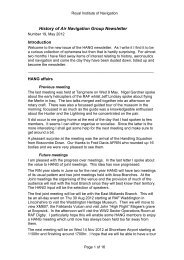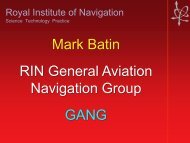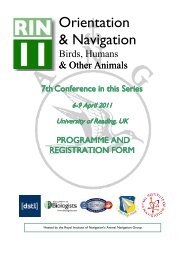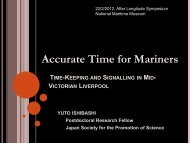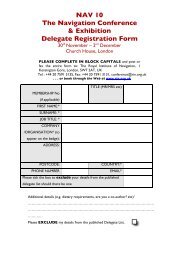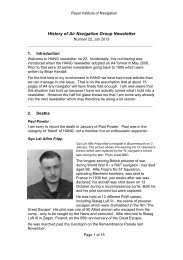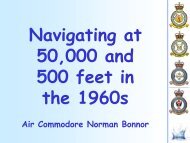Fairway 30 - Royal Institute of Navigation
Fairway 30 - Royal Institute of Navigation
Fairway 30 - Royal Institute of Navigation
Create successful ePaper yourself
Turn your PDF publications into a flip-book with our unique Google optimized e-Paper software.
winds come driven snow which reduces the visibility to metres and this can persist for<br />
some days. The wind also causes spray which in turn leads to ice accretion. As example,<br />
over <strong>30</strong>0 tons <strong>of</strong> ice can accumulate on a ship’s forepart in one night <strong>of</strong> bad weather in<br />
freezing conditions.<br />
Another effect <strong>of</strong> the wind is the wind chill factor, which governs the sustainability <strong>of</strong><br />
those exposed. When judging wind chill factor, the speed <strong>of</strong> the boat or ship must be<br />
added to that <strong>of</strong> the wind. Thus a ship making 20 knots against a 20 knot wind produces<br />
40 knots <strong>of</strong> wind. At a temperature <strong>of</strong> -20˚C the wind chill factor therefore increases to<br />
-55˚C.<br />
Ice islands occasionally break away from northern Ellesmere Island, and icebergs are<br />
formed from glaciers in western Greenland and extreme northeastern Canada, however<br />
small ice floes can be abundant at any time. On average in the Northern Hemisphere, sea<br />
ice is at a minimum in September, and at a maximum in March. In the Southern<br />
Hemisphere, these times are nearly opposite; minimum in March and maximum in<br />
September.<br />
Potential<br />
Speaking at a meeting <strong>of</strong> the Arctic Council in Yakutsk, Vladimir Morgunov, assistant<br />
to the Russian Economic and Trade Minister, said: “The Arctic Council states should<br />
take steps that would enable them to minimize the damage caused by potential<br />
negative effects while taking maximum advantage <strong>of</strong> positive effects <strong>of</strong> the global<br />
warming”. The Northern Sea Route may be completely ice-free by 2020-2035 if arctic<br />
ice continues to thaw at a present pace. In that case a short transportation route going<br />
across Russia will connect Europe with Southeast Asia. According to Mr. Morgunov,<br />
“the route will have great potential for cargo traffic”.<br />
A fully opened Northern Sea Route could shorten the journey for goods and raw<br />
materials from Northeast Asia to Europe by 40 percent. Russia is also preparing<br />
legislation to impose tight controls over navigation through its northern coasts as the<br />
reduction in Arctic sea ice makes the route more commercially appealing to shipping.<br />
These controls include the ability to refuse military vessels, impose fees on shipping<br />
using the route and a requirement for vessels to be escorted.<br />
Pollution<br />
One <strong>of</strong> the major concerns <strong>of</strong> the Arctic council is pollution. Interestingly they are more<br />
concerned at the pollution from the oil and gas field support ships than from these<br />
facilities. While coping with oil pollution in the Arctic is a major problem that still has<br />
to be dealt with, there is another pollution concern waiting in the wings.<br />
Between 1964 and 1986, some 7,000 tons <strong>of</strong> solid radioactive waste and 1,600 cubic<br />
metres <strong>of</strong> liquid waste was pitched into the Kara and Barents Seas from the base in<br />
Murmansk which serviced the Soviet fleet <strong>of</strong> nuclear powered naval and merchant ships.<br />
27






